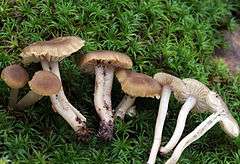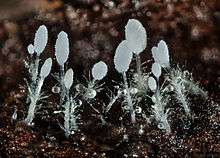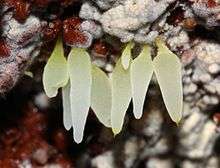Clavariaceae
| Clavariaceae | |
|---|---|
 | |
| Clavulinopsis corallinorosacea | |
| Scientific classification | |
| Kingdom: | Fungi |
| Division: | Basidiomycota |
| Class: | Agaricomycetes |
| Order: | Agaricales |
| Family: | Clavariaceae Chevall. (1826) |
| Type genus | |
| Clavaria Vaill. ex L. (1753) | |
| Genera | |
|
Camarophyllopsis | |
The Clavariaceae are a family of fungi in the order Agaricales. Collectively, they are commonly known as coral fungi due to their resemblance to aquatic coral, although other vernacular names including antler fungi, finger fungi, worm mold, and spaghetti mushroom are sometimes used for similar reasons.
Taxonomy
Clavariaceae was circumscribed (as "Clavariae") by French botanist François Fulgis Chevallier in 1826.[1] It was one of five families (along with the Agaricaceae, Hydnaceae, Polyporaceae, and Thelephoraceae) that Elias Fries used to divide the Agaricales and Aphyllophorales in his influential work Systema Mycologicum. The family served as a convenient placement for all genera containing species with superficially similar coral-like fruitbodies. It was first Marinus Anton Donk and later E.J.H. Corner who realized that in this broad sense, the family was not a natural phylogenetic assemblage of related species.[2] Corner published his world monograph in 1950 (revised in 1967 and updated in 1970), introducing the modern concepts of many genera of clavarioid fungi.[3][4] Corner included three genera in his original concept of the Clavariaceae: Clavaria, Clavulinopsis, and Ramariopsis.[3] Molecular phylogenetic analysis has since shown that the Clavariaceae belong to the order Agaricales.[5]
Camarophyllopsis, a gilled mushroom which had previously been placed in the family Hygrophoraceae based on its morphology, was found to belong in the Clavariaceae by Matheny et al. (2008) in a multilocus DNA study.[6] Although traditionally classified in Clavariaceae based on morphology, molecular phylogenetic analysis suggests that Scytinopogon clusters within the genus Trechispora (order Trechisporales).[7]
Molecular genetics has shown that some superficially similar species are not so closely related. The fairy club genus Clavariadelphus, Ramaria and Clavulina belong to the family Gomphaceae, Lentaria belongs in the order Thelephorales, while the genus Calocera is a member of Dacrymycetes, a different class of fungi entirely. The fungus once known as Clavaria purpurea has been moved to its own genus, Alloclavaria in the order Hymenochaetales.[8]
Description
Coral fungi can be similar in appearance to jelly fungi. They are often brightly colored, mostly oranges, yellows, or reds, and usually grow in older mature forests. Hyphodontiella is the sole genus of corticioid (crust-like) fungi in the Clavariaceae.
Habitat and distribution
Some Clavariaceae species have a cosmopolitan distribution, or nearly so. For example, Clavaria fragilis has been recorded on five continents. Other widely distributed species include Ramariopsis pulchella, known from North and South America, and New Zealand, and Clavulinopsis laeticolor, which is also found in Malaysia. In contrast, some groups of species, such as dark-colored Clavulina, are typically found on only a single continent, and may be quite rare.[9]
Ecology
The trophic status of the Clavariaceae has been debated in the scientific literature. It has been variously described as saprotrophic,[10] mycorrhizal,[11][12] or unknown.[13] Experimental techniques commonly employed to determine trophic strategy, such as stable isotope analysis and phylogenetic analysis of environmental sequences (DNA that is released from an organism into the environment), have not often been used with Clavariaceae species. Birkebak and colleagues suggest that, excluding lignicolous (wood-decaying) species, the Clavariaceae are biotrophic.[7]
Genera
A 2008 estimate placed 7 genera and 120 species in the family;[14] Hirticlavula was added to the family in 2014.[15] In 2013, Birkebak and colleagues suggested that there were 126 operational taxonomic units in the Clavariaceae, about half of which were known from environmental DNA sequences.[7]
- Camarophyllopsis Herink 1958 – agaricoid
- Clavaria Vaill. ex L. 1753 – clavarioid
- Clavulinopsis Overeem 1923 – clavarioid
- Hirticlavula J.H.Petersen & Læssøe 2014 – clavarioid
- Hyphodontiella Å.Strid 1975 – clavarioid
- Mucronella Fr. 1874 – hydnoid
- Ramariopsis (Donk) Corner 1950 – clavarioid
- Scytinopogon Singer 1945 – clavarioid
- Setigeroclavula R.H.Petersen 1988 – clavarioid
See also
References
- ↑ Chevallier FF. (1826). Flore Générale des Environs de Paris (in French). 1. Paris, France: Ferra Jeune. p. 102.
- ↑ Donk MA. (1964). "A conspectus of the families of Aphyllophorales". Persoonia. 3 (2): 199–324 (see pp. 250–253).
- 1 2 Corner EJH. (1950). A Monograph of Clavaria and Allied Genera. Annals of Botany Memoirs. 1. Cambridge, UK: Cambridge University Press.
- ↑ Corner EJH. (1970). Supplement to ‘A Monograph of Clavaria and Allied Genera’. Nova Hedwigia Beihefte. 33. Lehre, Germany: J. Cramer.
- ↑ Pine EM, Hibbett DS, Donoghue MJ (1999). "Phylogenetic relationships of cantharelloid and clavarioid Homobasidiomycetes based on mitochondrial and nuclear rDNA sequences". Mycologia. 91 (6): 944–963. doi:10.2307/3761626.
- ↑ Matheny PB, Curtis JM, Hofstetter V, Aime MC, Moncalvo JM, Ge ZW, Slot JC, Ammirati JF, Baroni TJ, Bougher NL, Hughes KW, Lodge DJ, Kerrigan RW, Seidl MT, Aanen DK, DeNitis M, Daniele GM, Desjardin DE, Kropp BR, Norvell LL, Parker A, Vellinga EC, Vilgalys R, Hibbett DS (2006). "Major clades of Agaricales: a multilocus phylogenetic overview" (PDF). Mycologia. 98 (6): 982–95. doi:10.3852/mycologia.98.6.982. PMID 17486974. Archived from the original (PDF) on 2016-03-03.
- 1 2 3 Birkebak JM, Mayor JR, Ryberg KM, Matheny PB (2013). "A systematic, morphological and ecological overview of the Clavariaceae (Agaricales)" (PDF). Mycologia. 105 (4): 896–911. doi:10.3852/12-070. PMID 23396156.

- ↑ Dentinger BT, McLaughlin DJ (2006). "Reconstructing the Clavariaceae using nuclear large subunit rDNA sequences and a new genus segregated from Clavaria". Mycologia. 98 (5): 746–762. doi:10.3852/mycologia.98.5.746. PMID 17256578.
- ↑ Kautmanová I, Tomšovský M, Dueñas M, Martín MP (2012). "European species of Clavaria (Agaricales, Agaricomycetes) with dark basidiomata – a morphological and molecular study". Persoonia. 29: 133–145. doi:10.3767/003158512X661543. PMC 3589790
 . PMID 23606770.
. PMID 23606770. 
- ↑ Rinaldi AC, Comandini O, Kuyper TW (2008). "Ectomycorrhizal fungal diversity: separating the wheat from the chaff" (PDF). Fungal Diversity. 33: 1–45.
- ↑ Englander L, Hull RJ (1980). "Reciprocal transfer of nutrients between ericaceous plants and a Clavaria sp.". New Phytologist. 84: 661–667. doi:10.1111/j.1469-8137.1980.tb04779.x.
- ↑ Trappe JM. (1962). "Fungus associates of ectotrophic mycorrhizae". Botanical Review. 28 (4): 538–606. doi:10.1007/BF02868758.
- ↑ Tedersoo L, May TW, Smith ME (2010). "Ectomycorrhizal lifestyle in fungi: global biodiversity, distribution and evolution of phylogenetic lineages". Mycorrhiza. 20 (4): 217–263. doi:10.1007/s00572-009-0274-x. PMID 20191371.
- ↑ Kirk PM, Cannon PF, Minter DW, Stalpers JA (2008). Dictionary of the Fungi (10th ed.). Wallingford, UK: CAB International. p. 149. ISBN 978-0-85199-826-8.
- ↑ Petersen JH, Davey ML, Læssøe T (2014). "Hirticlavula elegans, a new clavarioid fungus from Scandinavia" (PDF). Karstenia. 54 (1): 1–8.


_Corner_95377_cropped.jpg)
